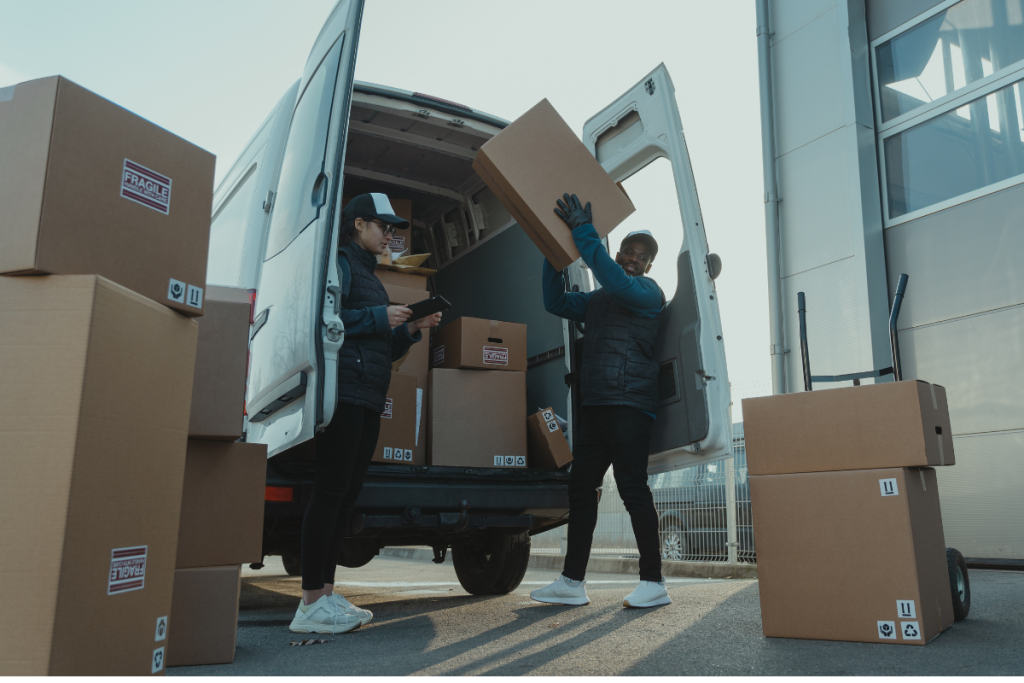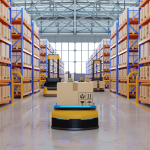The final stretch of product delivery, the last mile, has become a focal point for innovation, driven by the surge in e-commerce and heightened consumer expectations. Companies are exploring advanced technologies and novel strategies to enhance efficiency, reduce costs, and improve customer satisfaction.
From autonomous vehicles to AI-driven logistics, here are ten groundbreaking innovations reshaping last-mile delivery in 2025.
Top 10 Innovations in Last-Mile Delivery
1. Autonomous Delivery Robots
Amazon is advancing its automation efforts by developing AI-powered humanoid robots for package delivery. According to reports, the company is nearing completion of a facility dubbed the “humanoid park” in San Francisco, designed for training robots to deliver packages. These robots are intended to ride in Rivian electric delivery vans and autonomously unload and deliver packages to customers’ doors.
The company is already testing several humanoid robot models, including Agility Robotics’ Digit and a $16,000 robot from Unitree, at the facility. These robots promise to reduce labor dependency and fill service gaps in dense urban areas, but integrating them will require rethinking workflows and ensuring that human oversight is built into every autonomous link in the chain.
2. Drone Deliveries
Zipline, in partnership with Walmart, has launched drone delivery services in Texas, offering aerial transport of more than 65,000 products in 30 minutes or less, even in adverse weather conditions. The drones can carry up to eight pounds within a 10-mile radius, enhancing delivery speed and accessibility.
For logistics leaders, drones represent a strategic hedge against road congestion and labor shortages. But their real value lies in high-value, lightweight goods and in extending reach to underserved geographies. The regulatory landscape remains a work in progress, but the early pilots point to a future where drones complement, not replace, ground networks.
3. Micro-Fulfillment Centers (MFCs)
Ocado’s automated grocery fulfillment centers exemplify the shift towards micro-fulfillment. These centers use advanced robotics to process orders efficiently, reducing the time and cost associated with last-mile delivery. The technology includes lighter grids, more efficient bots, and robotic arms able to directly pick products.
MFCs offer a compelling option to decentralize inventory—reducing delivery times and transportation emissions. But the capital investment is significant, and success hinges on data-driven demand forecasting to avoid overstocking or underutilization.
4. AI-Powered Route Optimization
UPS’s ORION route optimization system uses AI to calculate optimal delivery paths, processing 30,000 route optimizations per minute and saving 38 million liters of fuel annually. The system prevents approximately 100,000 metric tons of carbon dioxide emissions each year.
AI route optimization significantly improves route planning efficiency by quickly processing large datasets and making real-time adjustments. This capability is crucial for businesses looking to streamline their operations and respond swiftly to changing conditions. With AI route optimization, companies can achieve faster delivery times, reduce idle times, and enhance overall productivity.
5. Gig Economy Platforms
Platforms like Uber and DoorDash are expanding their services beyond food delivery, offering logistics solutions for various goods. This expansion allows for flexible, on-demand delivery options, catering to the increasing demand for rapid and convenient service.
For logistics leaders, these platforms offer elastic capacity during peak demand, but they also raise questions around service consistency and brand reputation. Careful management, via standardized protocols and real-time tracking, is essential to leverage gig flexibility without compromising the customer promise.
6. Contactless Delivery
The COVID-19 pandemic accelerated the adoption of contactless delivery methods. Companies have implemented systems such as smart lockers and app-based confirmations to minimize physical contact, ensuring safety and convenience for both customers and delivery personnel. This trend continues to evolve, with businesses enhancing their contactless delivery infrastructure.
Smart locker solutions offer convenient, contactless package delivery and pickup, keeping both staff and recipients safe. These intelligent systems simplify parcel delivery, optimize asset management, and offer secure, contactless storage, resulting in improved operational workflows and enhanced user experiences.
7. Green Delivery Initiatives
UPS’s rollout of over 100 electric vehicles in Paris—and plans to deploy 600 more in Europe by year-end—showcases the convergence of sustainability and logistics. These EVs, part of a 1,000-vehicle global fleet, are key to UPS’s goal of 40% alternative fuel usage by 2025.
For logistics leaders, green delivery is no longer just about compliance, it’s a competitive advantage as customers and regulators push for lower emissions. EV adoption also opens up access to zero-emission zones in cities, future-proofing last-mile strategies for a rapidly decarbonizing economy.
8. Customer-Centric Tracking and Communication
Real-time order tracking is crucial for delivering a great post-purchase experience. Platforms like Shopify have integrated real-time inventory management to help track stock levels, fulfill orders faster, and keep customers informed across all sales channels, enhancing transparency and customer satisfaction.
Order tracking apps let customers know where their package is and how long it’ll take to arrive. These apps provide real-time tracking features, allowing customers to chart the progress of each order on a live map when using supported carriers. This level of transparency enhances the customer experience and builds trust in the delivery process.
9. Hyperlocal Delivery Networks
Instacart has expanded its services to include 30-minute delivery options, focusing on building hyperlocal delivery networks. This approach allows for rapid delivery within specific neighborhoods, meeting the demand for immediate service and supporting local businesses.
For logistics leaders, hyperlocal networks require a rethink of hub-and-spoke models. The challenge is to balance hyperlocal flexibility with the economies of scale of centralized networks, ensuring that speed doesn’t come at the expense of margin discipline.
10. Predictive Demand Shaping
Amazon’s experiments with generative AI mapping tools and predictive demand signals mark a new frontier: anticipating demand before it happens. By tailoring inventory and transport capacity to likely demand spikes, predictive shaping can eliminate bottlenecks before they occur.
For logistics leaders, last-mile delivery is evolving into a critical lever for market competitiveness, shaping fulfillment efficiency, cost management, and customer loyalty. ying predictive models to last-mile networks can turn delivery from a reactive scramble into a proactive competitive advantage.
Building Agile Last-Mile Networks
Last-mile delivery has become a testing ground for new ideas and technologies—whether in predictive analytics, autonomous vehicles, or hyperlocal networks. These developments demand a disciplined yet adaptive approach from logistics leaders.
The key challenge is to integrate these technologies into cohesive supply networks that balance cost, speed, and sustainability. Leaders must weigh the operational gains of each innovation against broader supply chain priorities, including labor dynamics, regulatory changes, and customer expectations. In a world where the final mile increasingly defines the customer experience, agility and precision are the new watchwords of logistics success.







